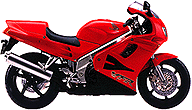

This article was written by Mike Guillory and he has graciously allowed me to post it here. The original post was in response to a VFR Lister who asked ... How do oil filters work?
IntroductionThat, my friends, I will try to answer briefly below, since I have recently run across a few mechanics and motorcyclists who don't seem to know. Our modern VFRs (not sure about the 1986 to 1989 models) use freshly-filtered oil to lubricate the internals of the motor, and that spin-on filter is there to remove any particles before they get to the motor. But what exactly is going on inside?
Assuming that your filter *fits* (e.g. threads, baseplate, gasket, outer dimensions), then the two (2) important components are the bypass valve and the filtration medium.
The Bypass Value
First you need to understand why the bypass valve is there. Under *ideal* conditions, the bypass valve will *never* open. Because, when it opens, the oil *by passes* the filter and goes on through to the motor, obviously unfiltered. It is a safety valve. However, in *real* operation, it opens often.
- One example is when you start the motor when cold. The oil is thick and does not pass easily through the filtration medium, thus building up to a high pressure drop. So, the bypass valve opens to prevent oil-starvation of the motor. How long it stays open is dependent on how cold the oil is and how long it takes to get near operating temperature. When the pressure drop across the filtration medium drops below the bypass valve setting, then the bypass closes. Blipping the throttle while warming up is a good way to get the valve to open and send unfiltered oil to the motor. A steady warm-up rpm is probably a lot better.
- Another example can occur when the motor is fully warmed. At idle, the oil pressure is about 15 to 20 psi, and the pressure drop across the filter is about 1 or 2 psi. You take off towards the redline, and quickly build oil pressure to the 70 to 80 psi range. During that full-throttle acceleration the pressure drop across the filter will exceed the bypass setting, and send unfiltered oil to the motor, until the pressure across the filter has time to equalize. During a drag race, shifting through the gears, the bypass will open several times.
- A third example, which you should never experience with frequent oil and filter changes, is when a filter becomes clogged. A spin-on filter can commonly hold 10 to 20 grams of trash before it becomes fully clogged. The bypass valve opening is the only way to keep the motor from becoming oil-starved if the filter becomes clogged.
According to Purolator, the Honda OEM filter bypass setting is 12 to 14 psi, and that is how they build their motorcycle oil filter. WIX (NAPA Gold) builds their motorcycle and automobile oil filters with a bypass setting of 8 to 11 psi, while AC Delco builds theirs to a setting of 11 to 17 psi. How much do these differences matter? I don't think anyone knows, even the engineers, and each has its own set of advantages and disadvantages.
- If you do lots of racing, you're probably better off with a higher bypass setting.
- If you do lots of *cold* starting, especially in the winter, or seldom change your filter, I think you're better off with a lower bypass setting. However, with few exceptions, bypass pressures for spin-on filters run in the 8 to 17 psi range, and any of them should work acceptably.
How About the Filtration Medium?
In general, the more expensive filters have better filtration. Even if two (2) different filters look identical on the outside, they very well may have different filtration media inside them. There are really 4 levels of filters:
Where do the Honda OEM filters fit in the above classes? Hard to tell, however probably in the "midgrade" category, possibly the "conventional".
- Dealer/Lube Shop Brands - Pennzoil, Valvoline, Quaker State - These are generally lowest quality capturing 40 micron sized particles.
- Conventional- Fram Extraguard, Purolator, ACDelco Duraguard, Wix - These are around 25 micron filters.
- Mid-grade - PureOne, Fram Toughguard, ACDelco Duraguard Silver (coming in August) - These are generally 10-20 micron filters.
- Premium - ACDelco Ultraguard Gold- 8-10microns, Mobil One-10-12 microns.
The spin-on filters also have "anti-drain back" valves which simply keeps oil from flowing backward and emptying the filter when the motor is shut down. They either work or they don't. I don't have any other information, and it probably isn't worth worrying any about.
Notes: The above summary comes from many hours of discussions with Technical Reps at filter manufacturers plus many hours studying filter catalogs and Internet sites. Why? Just because I was curious.
- Please refer to Motorcycle Motor Oil for a comprehensive review of various motor oils and
- To Oil Filter Alternatives - Honda Motorcycles for a comprehensive review of various oil filters. Both articles are by Mike Guillory.
- The author is a Chemist, retired from a major Oil and Chemical Company, after a career in the Quality Assurance of Fuels, Lubricants, and Chemical products. He and his wife both ride.
Mike in Houston
'94 VFR750 "XENA"
'85 V65 Magna "YELLOW SONIA"
